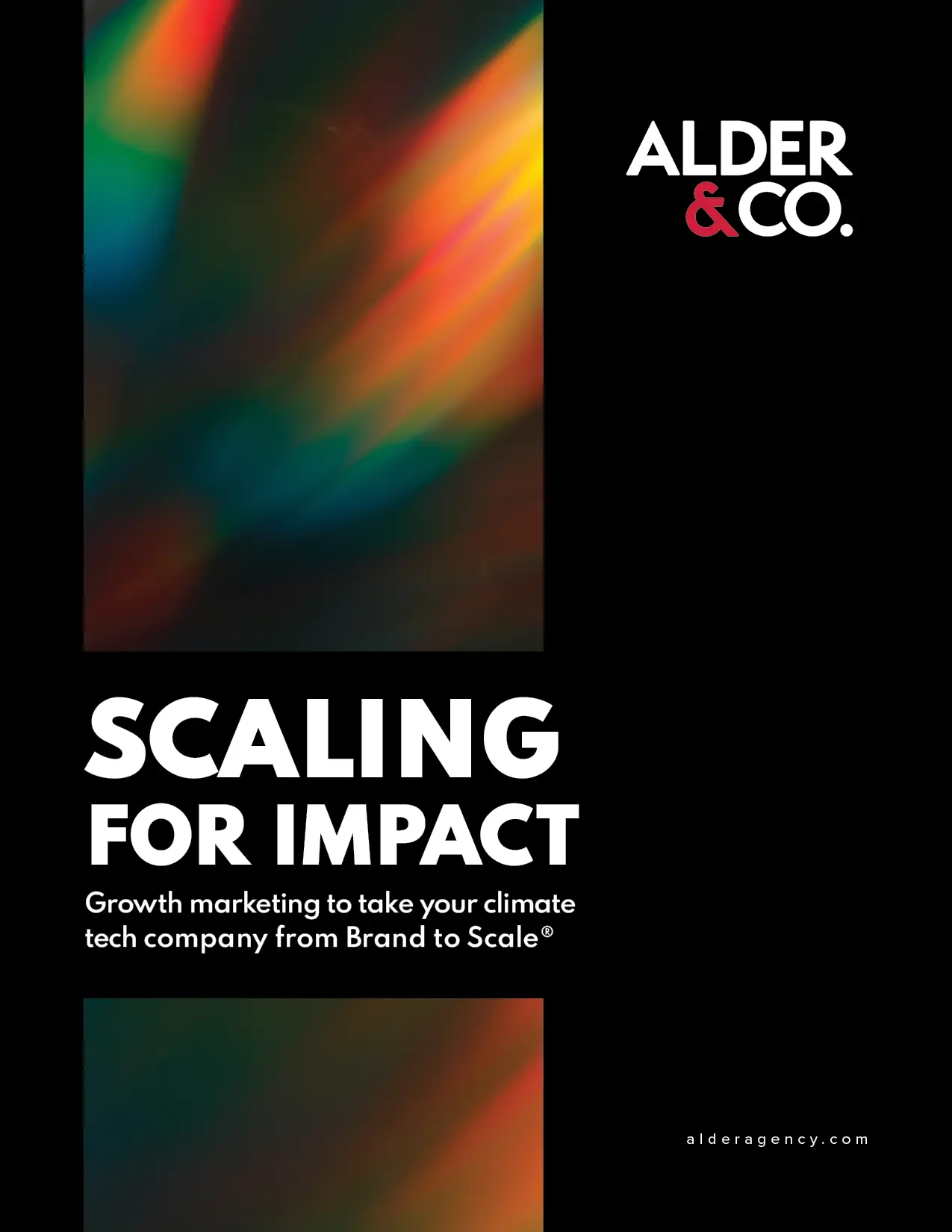
Scaling any startup is a challenge, and climate tech entrepreneurs face a uniquely difficult set of obstacles. The often-referenced “Four Valleys of Death” – turning a breakthrough technology into a startup, finding product-market fit, getting market validation for their offering, and establishing a track record of profitability and scalability – illustrate the many pitfalls inherent in bringing breakthrough ideas into a market with deeply entrenched ways of doing business.
Fortunately, marketing can support ways through each valley and expert leaders willing to share their experiences on how to get across those valleys. In our recent panel discussion at San Francisco Climate Week, “Becoming a Unicorn: Growth Marketing for Taking Your Company Brand to Scale,” we brought together four marketing leaders from top climate tech companies to share their invaluable insights and lessons learned from their experiences scaling climate tech companies: Kate Stirr from Natel Energy, Kendall Cody from WeaveGrid, Mona Khaldi from Voltus, and Kristan Kirsh from Nextracker. Here are the five key takeaways from our discussion:
1. Define your brand early
Your brand is more than just a logo or tagline; it’s how customers feel about your company and what you’re promising to deliver. At Alder, we believe that your brand should be a priority from day one. Kristan Kirsh reinforced this idea during our panel when she stressed the need to, “decide what you want your company to be and what you want it to stand for. It seems easy, but it’s really hard to say in one sentence what you do.”
Investing in branding early on gives your team a clear set of guidelines to inspire their work. It’s not just that a well-crafted messaging framework and visual identity simplifies the hard work of marketing and communications. Putting in the time to align on mission, vision, and values creates a touchstone that everyone on your team can refer back to for every decision.
It also makes it easy to explain your priorities, your work, and what makes you different from the competition. Kirsh again: “Ask yourself, will this have staying power throughout our funding rounds? Think of the beginning of building a brand as scaffolding. Understand what your brand pillars are and create your messages around those brand pillars.” One example is a story Kate Stirr shared about the early days at Natel Energy. They decided to make a photographer one of their first marketing hires because they wanted visual storytelling to be a core piece of the brand’s identity. Their striking visual media have been a core part of how Natel shows up in the world.
2. Explain your solution with simple, relatable storytelling
Climate tech solutions are often complex and difficult to grasp. Many startups understandably focus their communications on explaining the intricate details of technology, but according to Kate Stirr, that’s a mistake. Instead, she emphasizes the importance of simplifying your message and using storytelling to educate your audience. In other words, tell a story that outlines both the challenge at hand and how your product addresses it. As Stirr says, “Once you establish what problem you’re trying to solve, you have to say, here’s the solution that I’m proposing, but why does it matter? Talking about your technology in very plain language is super important to building that foundation of understanding.” By tying your solution directly to the problem it solves, you create context for your messaging. This makes it easier to communicate its value to your target audience.
3. Educate senior leadership on the value of brand marketing
Many climate tech founders are technical experts, which means they’re often unfamiliar with the role marketing plays in driving growth. Bringing company leaders up to speed on the importance of building the company’s brand ensures everyone is working towards the same goals. Kendall Cody discussed the importance of getting everyone on the same page for successful growth marketing. “We had to focus really early on building the brand identity, and at first, that was very tied up in our founder’s identity. As we grew, we needed to move on from that. We have a very charismatic founder and CEO, and he’s out there speaking quite a bit, and we’ve intentionally developed both a visual brand identity and a company positioning that goes beyond our founder’s story.”
Convincing senior leadership of brand marketing’s value ensures you have the necessary resources to grow the company. Working closely with senior staff, sales, and technical teams keeps marketing and business goals closely aligned. That keeps everyone pulling in the same direction, toward a common goal you all want to reach.
4. Align marketing with sales and learn from your customers
Marketing should not operate in a silo. In fact, all those brand materials you created early on can be just as valuable to sales efforts as they are to the marketing communications (MarCom) team. And, as Kristan Kirsh emphasized, it’s a two-way street: “Start spending time with your sales team. Get on the phone with them, go on a road show with them, sit in their customer meetings.”
By collaborating closely and aligning the efforts of your sales and marketing team, you can learn a tremendous amount about your customers’ needs, challenges, and preferences. These insights are a key way to refine and focus your marketing efforts over time. Draw on them to create even more detailed buyer personas, to refine and optimize campaign messaging, and potentially even to guide product marketing and development efforts. Your customers are telling the sales team what they want. Make sure you listen to them.
5. Find your swiss army knife
When building your marketing team, Mona Khaldi has a unique suggestion for your startup’s early days. She recommends companies “find someone who’s a Swiss army knife, especially gritty. They don’t need to know everything or be an expert, but they need to be really gritty.” In the early stages, an adaptable, resilient marketer who is willing to wear different hats is incredibly valuable. You’re looking for someone who can think strategically about the big picture while executing distinct marketing tactics across multiple channels.
Maybe you already have this person. Maybe you’re still looking. This person might even be you! What matters is that you bring them on early so they can embed this flexible, determined, and creative workstyle deep in the marketing team’s DNA. That way, you’ve installed a strong foundation and team culture that you can build on as the company grows and hires more specialized roles.
Be the climate tech unicorn you wish to see in the world
Depending on where your climate tech company is in its growth journey, some of these pieces may already be in place. Some might be new ideas that will kick off your next growth phase. All of them are worth keeping in mind as you build a framework for future scale and position your company for long-term success.
That’s not to say these five rules encompass everything there is to know about growth marketing for climate tech brands. There’s much more to say about a brand’s role in marketing, the importance of buyer personas and actionable insights, and many more topics. In our newly published e-book, “Scaling for Impact: Growth Marketing to Take Your Climate Tech Company From Brand to Scale®”, you can read a much more comprehensive account of how to scale a climate tech brand.
At Alder, we specialize in supporting climate tech companies at every stage of their growth journey with strategic marketing and branding efforts designed to fuel growth. Get in touch if you’re ready to take the next step in scaling your climate tech company! You can book a time on our calendars here.


